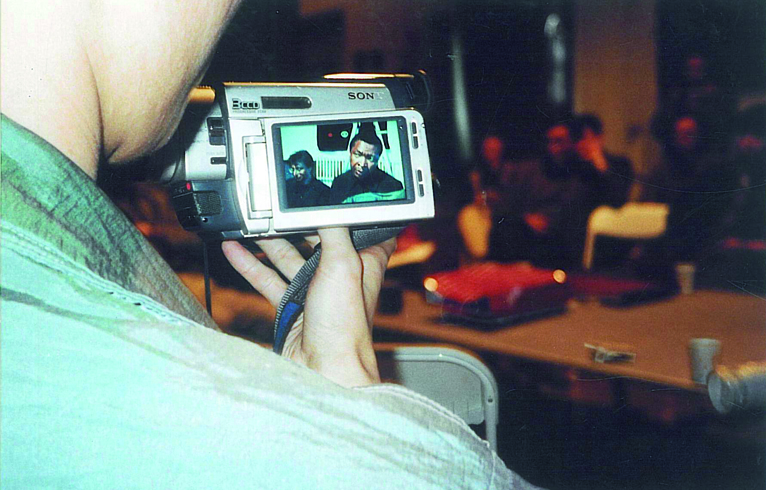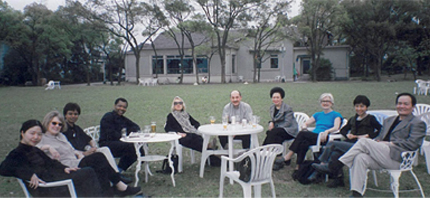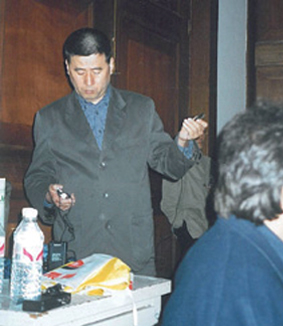TEN-DAY TOUR
| December 6, 2011 | Post In LEAP 11

IN 2002 OKWUI ENWEZOR curated Documenta XI. As exhibitions go, it was a sort of Bretton Woods moment, setting the parameters of a conversation about the relationship between art and global geopolitics that stayed in place for over a decade. It also coined a format for large-scale exhibitions in an implicitly global age, including a conception of the exhibition as spanning multiple “platforms” beyond the exhibition proper, an extended team of interlocutors, and a focus on work that said something about one national situation or another. Derided by some as “The CNN Documenta,” it stands, a decade later, as a monument to a now bygone moment, frequently copied but rarely if ever surpassed. It prefigured the notion of the sprawling biennial, encompassing multiple forms and venues, which is currently itself the subject of a minor backlash (see: Gwangju 2010, Istanbul 2011).
In preparation for this exhibition, a group of curators arrived in China on April 14, 2000, looking to engage the Chinese art scene in its unfolding global conversation. Led by Enwezor, it also included— all affiliations dated 2000— Dia Foundation director Lynn Cooke, philosopher Sarat Maharaj, Gate Foundation director Sebastian Lopez, Renaissance Society executive director Suzanne Ghez, Museum Boijmans von Beuningen director Chris Dercon, and artist Ken Lum. As some, but not many, Western curators had done at that point, they would spend ten days traveling among Greater China’s major art centers, seeing for themselves where the discourse stood and how they might intervene in it.
Like many things in the Chinese art world at that time, this trip was supported by Annie Wong, a minor Hong Kong philanthropist with an elegant bouffant and an endless wardrobe of retro skirt-suits. The Virgil to their collective Dante was played by Zheng Shengtian, the legendary artist, professor, and mentor to the ’85 New Wave generation who boasted better inside knowledge of his homeland and its art scene than perhaps anyone alive. (Fittingly, the trip began in Hangzhou, the city where Zheng had studied and later taught.) In the opening sequence of the two-hour video made by an assistant and tracking the group’s progress around the country, the curators sit by the West Lake, drinking what we can safely assume to be room-temperature beer.

A night later, in a room of rattan chairs, checkered tablecloths, and enameled zisha cups, Enwezor and current China Academy of Art president Xu Jiang toast each other. Dinner is cleared and a debate begins, lasting well into the night. In the school auditorium the following day, Enwezor invokes “the complex shuttle between tradition and modernity, how they can journey into each other to produce new models of being in the world.” Maharaj adds, “Picasso was never called the Zhang Daqian of Europe.” Lopez reflects on a recent show of Chinese artists that was “not a Chinese show.” Later on they sit with artists like Geng Jianyi and Zhang Peili. Zhang ventures an extended medical metaphor, comparing herbal remedies and radiation treatments to Chinese and Western modes of art-making.
That such a high-profile group of curators considered it important to make this long journey— which went on to Shanghai, Beijing, Guangzhou, and finally Taipei— was a significant advance over the previous Documenta, a show from which Chinese artists felt so isolated that one duo, Yan Lei and Hong Hao, made a performance of sending last-minute, fake invitation letters to a hundred of their colleagues, informing them of their selection for a spurious add-on exhibition entitled “From the Other Shore: Contemporary Chinese Art.” Yan Lei— who participated in the 2007 edition of Documenta and is said to be included in next year’s instantiation as well— memorialized the trip with a painting entitled The Curators, a crudely painted composition based on a snapshot of the group, which in later versions saw the curators cut from the canvas, leaving a silhouetted hole.
The trip was structured mainly as a listening tour, with discussions scheduled at every stop. In Shanghai, a closed symposium at the Shanghai Art Museum sees Ding Yi explaining how he decided to paint abstractly (he wanted out of political symbolism) and Qiu Zhijie arguing that the very change of nomenclature in Chinese, from “modern art” to “contemporary art” represented a fundamental compromise. In Beijing, in an artist’s studio, the assembled critics hold forth. Lu Jie sports his newly acquired Goldsmiths theory as artists including Lin Tianmiao and Zhang Xiaogang wriggle in their chairs. The talking stops only to greet a late-arriving Li Xianting. In Guangzhou, Lü Peng explains that his 1992 Guangzhou Biennial had actually accomplished all the goals of dialogue and openness that the other Chinese curators were then still striving for.

Of course this was also many of the curators’ first trip to China, so the itinerary included the standard A-List sites. In Shanghai they sip coffee atop the newly opened Jin Mao Tower; in Beijing they walk down Wangfujing shopping street, straight past posters for Zhang Guangtian’s Che Guevara play at the Capital Theatre. (Ironic photos are taken.) At one point, Enwezor even poses for the cameras with a stuffed plush panda.
But all this is a sideshow to what seem to be, by all accounts, a very serious series of revelations, many of them still relevant today. At the end of the road, Enwezor, speaking more or less for the group, summarized the experience: “What has been constant throughout our discussions has been the relationship between China and the West but more specifically, about the success of Chinese artists being ‘picked’ by curators from the West who then made them famous.” Enwezor argued that this first wave of internationally active Chinese artists succeeded “not so much because Western curators picked these people, but because for so many years there was a lack of contact and information…and so the opportunity to be able to have contact with these new spheres of production created a new consideration in what the so-called Western curators were thinking.”
After all the discussions, all the stilted meals, all the studio visits, Enwezor had an epiphany: “It’s not an epiphany in terms of ‘Oh my God, China has skyscrapers,’ but rather that there has not been an adequate theorization or reflection in terms of texts or books of what is going on.”

